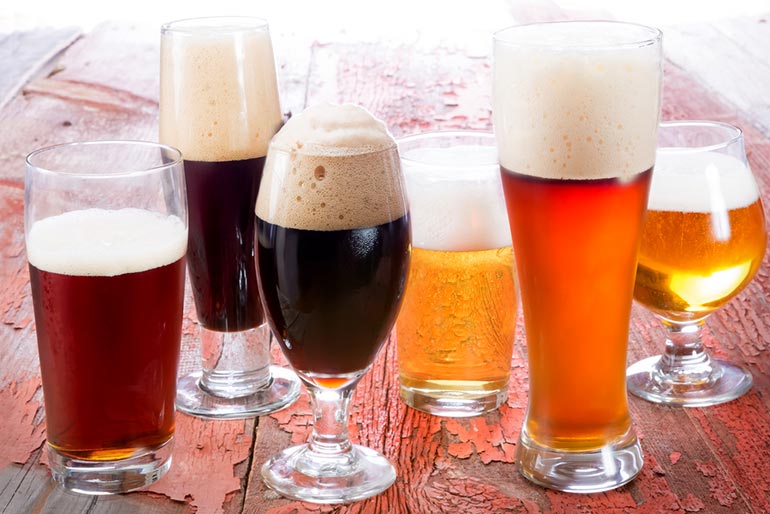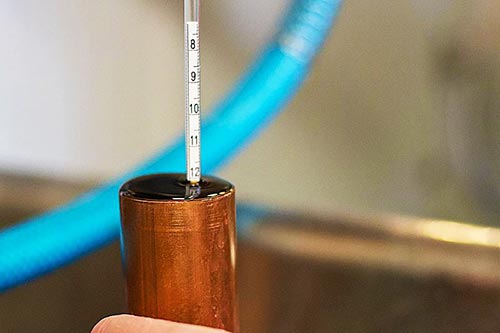Start 14-Day Trial Subscription
*No credit card required

Beer’s Vital Stats: ABV, IBU, SRM, OG (+ Other Useful Info)
Confused by beer acronyms like ABV, IBU, SRM, and OG? Discover how these vital stats reveal the essence of your favorite brews. Learn about alcohol by volume, bitterness units, color intensity and original gravity, and enhance your beer selection process. Grasp the basics with this concise guide.
While the acronyms of beer’s vital stats ‒ ABV, IBU, SRM and OG ‒ may seem like alphabet soup to the uninitiated, alcohol by volume, international bittering units, standard reference method and original gravity are all integral to understanding beer. In this article, we’ll define these vital stats and explain how they’re useful.
Have you ever stood in the beer aisle wondering, “What style am I in the mood for? Do I want a 22-ounce bomber, or a 4-pack of 16-ounce cans? Should I try a new brewery’s beer or just grab one of my go-tos?”
With so many options available for craft lovers, the easiest way to choose a brew is by style. However, knowing a beer’s vital stats can help your decision-making process ‒ specifically, a beer’s alcohol by volume (ABV), international bittering units (IBU), standard reference method (SRM) and, sometime (but not always), original gravity (OG).
ABV / Alcohol by Volume in Beer
Almost every beer a consumer will find on the shelf or on draft will have its ABV clearly labeled. Technically, alcohol by volume is defined as a standard measure of how much alcohol is contained in a given volume of an alcoholic beverage. It is defined as the number of milliliters (mL) of pure ethanol present in 100 mL of solution at 20°C (68°F). The number of milliliters of pure ethanol is the mass of the ethanol divided by its density at 20 °C.
While that rather sticky scientific definition might be a mouthful, the fact is the higher the ABV, the boozier a beer will be in its aroma and flavor.
For some, ABV is the most important factor for choosing a beer – or at least how many they down in a sitting. Large-scale lager fans will know that an American Lager or American Light Lager usually clocks in between 4 and 5 percent ABV, while Imperial Pastry Stout fans will scoff if a beer doesn’t hit at least 11 or 12 percent ABV.
Since the ABV standard is used worldwide for all alcoholic beverages, it is perhaps the most important element of a beer’s vital stats.

IBU / International Bittering Units
A slightly more obscure acronym among beer’s vital stats is a beer’s IBU total. IBUs stand for International Bittering Units ‒ a pretty good gauge of a beer’s bitterness. Any fan of hoppy beers, such as American IPAs or big, boozy Double IPAs, will know all about the IBU scale. You can read our full definition of the term in What’s The Meaning of IBU?.
Much like alcohol by volume, international bittering units have a scientific underpinning: IBUs measure the parts per million of isohumulone found in a beer. Isohumulone is the acid found in hops that gives beer its distinct bitterness. Though the IBU scale can be used as a general guideline for taste, with lower IBUs corresponding to less bitterness and vice versa, it's important to note that malt and other flavors can mask the taste of bitterness in beer.
Overall, the combination of ABV and IBU on a can or bottle of beer can convey an impressive amount of information when it comes to learning about a specific beer’s flavor and aroma profile.
Mikkeller IBU Photo Courtesy of Flickr/Bernt Rostad
SRM / Standard Reference Method
Beer style and style family play a large role in a beer’s appearance, but one vital stat actually quantifies appearance. While not quite as recognizable and widespread as alcohol by volume and international bittering units, SRM or Standard Reference Method is about as close as the beer world comes to a unified way of gauging color.
Multiple factors must be taken into account (many of which are outlined in What Determines the Color of Beer?), but Standard Reference Method is calculated by passing light of a particular wavelength through a 1-centimeter-deep sample of beer and measuring the amount of light absorbed by the beer in that sample.
While the Standard Reference Method scale ranges from 2-5 (where you find lighter styles like Pilsner, Light Lagers, Helles Lagers and Exportbier) all the way up to 70s and 80s, the human eye can only see so many colors (Mantis Shrimp we are not), so all beers beyond the upper 40s (Imperial Stouts, Black IPA, Barrel-Aged Baltic Porters) simply look opaque and black.
Moving further along the SRM scale, beers at 7-15 SRM are generally amber, encompassing amber ales, pale ales and most modern IPAs. In the 16-25 range, beers are mostly dark amber to brown, featuring Barleywines, brown ales and Oud Bruins, among others. Above 25 and up to the 40s is where stouts and porters make their home.
Though Standard Reference Method isn’t the end-all, be-all of a beer’s color, as malt varietal, adjuncts, hop usage and boil time all play a huge role in the color of beer, it serves as an easy-to-digest vital stat.
OG / Original Gravity
Another less common acronym on a beer’s label is OG, or original gravity. Though a wee bit more granular than, say, the easily understood numbers of ABV, IBU and SRM, original gravity is defined as the relative density of the wort – the liquid that will ferment and become beer.
That density revolves mostly around the quantity of fermentable sugars in the wort, which are fermented by the yeast and become alcohol. In terms of usefulness, OG is regarded as a guide to the alcoholic strength of the finished beer, but in a more brewer-friendly term than, say, ABV, which is very clear to anyone who wants to purchase any alcoholic beverage.
FG / Final Gravity
Directly related to OG, final gravity is a crucial metric in the brewing process and serves as a vital indicator of a beer's characteristics after fermentation. This measurement, often determined using a hydrometer or saccharometer, gauges the specific gravity, which is the density ratio between the beer and water.
As the fermentation process concludes, final gravity showcases the residual unfermented compounds within the beer. However, it's important to note that this measurement doesn't consider the unique property of alcohol produced during fermentation, as it's lighter than water. Consequently, this factor introduces a bias into the reading, resulting in what's known as "apparent extract" rather than "real extract."
Despite this limitation, Final Gravity remains an invaluable preliminary assessment at the end of fermentation. When coupled with the initial gravity reading, it becomes a powerful tool for estimating the approximate alcoholic content of the final beer product.
So there you have it. While beer’s vital stats might seem like an unapproachable series of letters, numbers and decimal places, the truth is that these four acronyms serve to paint a fairly detailed picture of a beer in a very small amount of space – perfect for the tiny climes of a beer’s can or bottle artwork.
While an immense amount of effort and work went into making these beers, consumers must be able to glance at a beer’s vital stats and immediately comprehend what they mean – and make more informed decisions as a result. Thanks to ABV, IBU, SRM and OG, that has never been easier.





